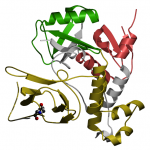Hypoxia and Inflammation: is HIF-1 a target for drug development?
I have a long-standing interest in hypoxia (lack of oxygen). Many years ago while completing my Masters degree in human physiology, I undertook research at the RAF Institute of Aviation Medicine at Farnborough on the effects of mild hypoxia on pilot performance.
So I was interested to read an article in the February 17, 2011 issue of the New England Journal of Medicine (NEJM) on hypoxia and inflammation, and how this influences disease. Inflammation is one of my blog themes for 2011, and in a previous post, I wrote about how its ubiquitous role has been characterized as one of the “Insights of the Decade”.
In the NEJM article on mechanisms of disease, the authors Holger Eltzschig and Peter Carmeliet discuss the cross-talk between hypoxia and inflammation, and how this is implicated in cancer, infections and inflammatory bowel disease.
A lack of oxygen (hypoxia) is something that humans are acutely aware of. We are all familiar with the flight/fight response that is designed to increase oxygen delivery to the brain and muscles. Hypoxia can also lead to an inflammatory response. The flip side is also true, where there is inflammation there is often local tissue hypoxia. An example of this is in solid tumors where the level of oxygen is considerably lower than in normal tissue.
 The link between hypoxia and inflammation is regulated by the hypoxia-inducible transcription factor (HIF) that is activated by hypoxia. HIF has two subunits HIF-α (consisting of HIF-1α and HIF-2α) and HIF-β. The article goes into detail (beyond the scope of this blog post) about the interaction between HIF and the nuclear factor kappa-B (NF-κB ) transcription factor that regulates inflammation.
The link between hypoxia and inflammation is regulated by the hypoxia-inducible transcription factor (HIF) that is activated by hypoxia. HIF has two subunits HIF-α (consisting of HIF-1α and HIF-2α) and HIF-β. The article goes into detail (beyond the scope of this blog post) about the interaction between HIF and the nuclear factor kappa-B (NF-κB ) transcription factor that regulates inflammation.
Elevated levels of HIF-1α and HIF-2α correlate with cancer deaths. HIF-1 overexpression is associated with tumor growth, vascularization and metastasis. This has led to HIF-1 being evaluated as a target for anti-cancer drugs.
EZN-2968, a novel HIF-1α antagonist is in phase I clinical trials. It is a joint development of two biopharmaceutical companies, Enzon in New Jersey and Santaris pharma in Denmark.
It will be interesting to see whether targeting hypoxia dependent signaling pathways will enable a clinically significant reduction in the inflammatory response.